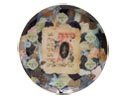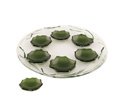 The
Passover Seder Plate Hebrew: ke'ara (קערה) is a
special plate containing symbolic foods used by Jews
during the Passover Seder. Each of the six items
arranged on the plate have special significance to the
retelling of the story of the Exodus from Egypt, which
is the focus of this ritual meal. The seventh symbolic
item used during the meal—a stack of three matzos—is
placed on its own plate on the Seder table. The
Passover Seder Plate Hebrew: ke'ara (קערה) is a
special plate containing symbolic foods used by Jews
during the Passover Seder. Each of the six items
arranged on the plate have special significance to the
retelling of the story of the Exodus from Egypt, which
is the focus of this ritual meal. The seventh symbolic
item used during the meal—a stack of three matzos—is
placed on its own plate on the Seder table.
The six items on the Seder Plate are:
* Maror and chazeret – Bitter herbs, symbolizing the
bitterness and harshness of the slavery which the Jews
endured in Egypt. For maror, many people mix freshly
grated horseradish with cooked beets and sugar to make
a condiment called chrein. (Note: If the horseradish
itself is cooked or pickled, it is not valid for the
Seder.) Whole horseradish root can also be eaten.
Chazeret is typically romaine lettuce, whose roots are
bitter-tasting. Either the horseradish or romaine
lettuce may be eaten in fulfillment of the mitzvah of
eating bitter herbs during the Seder.
* Charoset – A sweet, brown, pebbly mixture,
representing the mortar used by the Jewish slaves to
build the storehouses of Egypt. In Ashkenazi Jewish
homes, charoset is made from chopped walnuts, grated
apples, cinnamon, and sweet red wine. Sephardi recipes
call for dates and honey in addition to chopped nuts,
cinnamon, and wine. The choice of ingredients reflects
the various foods to which Israel is favorably
compared in King Solomon's Song of Songs.
* Karpas – A vegetable other than bitter herbs, which
is dipped into salt water at the beginning of the
Seder. Celery or boiled potato is usually used. The
dipping of a simple vegetable into salt water (which
represents tears) mirrors the pain felt by the Jewish
slaves in Egypt, who could only eat simple foods. The
consumption of the karpas early in the Seder is meant
to spark questions from the children at the table.
Usually in a Shabbat or holiday meal, the first thing
to be eaten after the kiddush over wine is bread. At
the Seder table, however, the first thing to be eaten
after the kiddush is a vegetable. This leads
immediately to the recital of the famous question, Ma
Nishtana—"Why is this night different from all other
nights?"
* Z'roa – A roasted lamb shankbone, chicken wing, or
chicken neck; symbolizing the korban Pesach (Pesach
sacrifice), which was a lamb that was offered in the
Temple in Jerusalem, then roasted and eaten as part of
the meal on Seder night. Since the destruction of the
Temple, the z'roa serves as a visual reminder of the
Pesach sacrifice; it is not eaten or handled during
the Seder.
* Beitzah – A roasted egg, symbolizing the korban
chagigah (festival sacrifice) that was offered in the
Temple in Jerusalem and roasted and eaten as part of
the meal on Seder night. Although both the Pesach
sacrifice and the chagigah were meat offerings, the
chagigah is commemorated by an egg, a symbol of
mourning (as eggs are the first thing served to
mourners after a funeral), evoking the idea of
mourning over the destruction of the Temple and our
inability to offer any kind of sacrifices in honor of
the Pesach holiday. Since the destruction of the
Temple, the beitzah serves as a visual reminder of the
chagigah; it is not eaten or handled during the Seder.
 Many
decorative and artistic Seder Plates sold in Judaica
stores have pre-formed spaces for inserting the
various symbolic foods. According to the Halakha
(Jewish law), however, the items must be arranged in
the order in which they will be used during the Seder,
with the first item to be used placed closest to the
leader of the Seder. Many
decorative and artistic Seder Plates sold in Judaica
stores have pre-formed spaces for inserting the
various symbolic foods. According to the Halakha
(Jewish law), however, the items must be arranged in
the order in which they will be used during the Seder,
with the first item to be used placed closest to the
leader of the Seder.
Table set for the
beginning of the Passover Seder, including Passover
Seder Plate (front center), bowl of salt water, three
shmurah matzot (rear center), and bottles of kosher
wine. A Hebrew language Haggadah sits beside each
place setting.
Table set for the beginning of the Passover Seder,
including Passover Seder Plate (front center), bowl of
salt water, three shmurah matzot (rear center), and
bottles of kosher wine. A Hebrew language Haggadah
sits beside each place setting.
The seventh symbolic item on the Seder table is a
plate of three whole matzot, which are stacked and
separated from each other by cloths or napkins. The
top and bottom matzot will be used for the hamotzi
(blessing over bread), while the middle matzah will be
broken and half of it put aside for the afikoman.
A bowl of salt water, which is used for the two "dippings"
of the Seder (once at the beginning of the Seder to
dip the karpas, and once before the meal begins to dip
a plain, hardboiled egg in remembrance of the chagigah)
is not a part of the Seder Plate, but is placed on the
table beside it. |